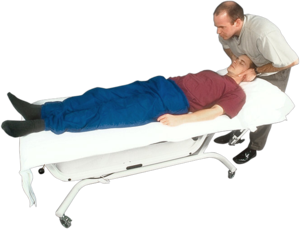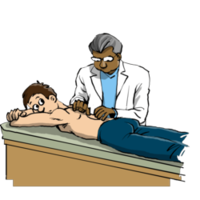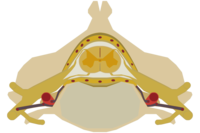Can a Pain in the Neck Raise Your Blood Pressure?

A chance discovery at the University of Leeds in the United Kingdom may give credence to longstanding claims by chiropractors that treating pain and stiffness by adjusting the neck can also lower blood pressure.
In a study published in the Journal of Neuroscience Jim Deuchars and his team report finding connections between rats’ neck muscles and a specific region of the brain. Their findings indicate that the neck muscles could play a key role in controlling blood pressure, heart rate and respiration.
They found that nerves run from receptors in the neck muscles to a region in the brainstem called the nucleus tractus solitarius that is known to be involved in the control of autonomic nervous system. It seems likely that signals from the neck could play a key role in ensuring an adequate supply of blood to the brain as we change position, for instance standing up suddenly. If the signaling system fails we may run into problems with low blood pressure (postural hypotension) and difficulties with balance.
Although it is early days, and it is a long way from a rat study to understanding human physiology, the finding may do more than provide a tentative explanation for the chiropractic reports. It may also explain another puzzle: why some people with whiplash injuries get trouble with their blood pressure. On the other hand, there have been a number of studies that have shown that the practice of yoga may help control blood pressure. It had been assumed that it was simply a consequence of generalized relaxation, but perhaps it is more specific than that: could a soft flexible neck be important in maintaining a healthy blood pressure?
The best research studies are the ones that suggest more questions than answers: on that criterion this is a most important study.
Non-pharmacological and Lifestyle Approaches to Attention-Deficit/Hyperactivity Disorder: 8. Massage and Manipulation

There is a small but persuasive literature on the value of massage and manipulation in people with attention-deficit hyperactivity disorder (ADHD).
Massage
The first study involved 28 adolescents with ADHD who were given either massage therapy or relaxation therapy for 10 consecutive school days. The massage therapy group, but not the relaxation therapy group, rated themselves as happier and observers rated them as fidgeting less following the sessions. After the 2-week period, their teachers reported more time on task and assigned them lower hyperactivity scores based on classroom behavior.
The second study was a randomized controlled trial involving 30 students aged 7-18 years. The results indicated that therapeutic massage given for 20 minutes twice a week produced significant improvements in both classroom behavior and mood.
There are a large number of studies that have shown that massage therapy can be helpful in managing anxiety in many different situations (1. 2.)
And it may also have some beneficial effects on the immune system.
Manipulation
There has been a great deal of interest in the notion that chiropractic manipulation may have an impact on the symptoms of ADHD.
A small study of seven children diagnosed with ADHD showed some improvements in ratings of hyperactivity.
There are some interesting case reports:
In the first a young girl who had been diagnosed with ADHD whose symptoms had failed to respond to an astonishing array of medications, but who improved once a cervical kyphosis was treated.
The second concerned a nine-year-old with Tourette’s and ADHD who showed a remarkable improvement after a course of chiropractic treatment.
The third concerned an 8-year-old with multiple learning and behavioral disorders associated with ADHD that improved after a course of chiropractic treatment. This case was rather different form the others in that the symptoms began after a fall, and it seems likely that the problems were at least in part due to pain and discomfort, and the child’s improvement may have been related to an improvement in both. The case highlights the importance of remembering that problems with mood, sleep and attention may be secondary to other medical or psychological maladies.
A recent review article on chiropractic care in people with learning disabilities and dyslexia does touch on ADHD and rightly concludes that the evidence so far is interesting but far from conclusive.
There is clearly a great deal of scope for further research into massage and manipulative therapies and ADHD.
I shall keep you posted if any more studies come out.
I am indebted to Dennis da Ponte from Life University in Atlanta for helping track down some of the papers that I referred to in this article.
Does the Spinal Cord Think?

In recent years we have become very interested in the ever-increasing evidence there are large complex neural networks outside the brain and autonomic nervous system. The main ones are in the intestine and the heart. These systems are so complex and well organized that some people have talked about us having a “brain” in the heart and another in the intestine. This may be a bit of an over-statement. For instance the cerebellum at the back of the brain is large and highly complex, but is so arranged that it probably cannot generate conscious experience. That particular trick needs a cerebral cortex that self-organizes, recruits new systems when necessary for some particular task and generates vast oscillations that are modulated by genes and the environment.
Now new research has shown that the spinal cord has some of those same properties that we associate with the cerebral cortex. This groundbreaking work has just been published in the journal Science, and the entire paper is available here.
So why the excitement and interest? It often astonishes me how many students who come to my lectures seem not to have a curiosity gene. And there is so much about which we should be curious. Despite the billions spent on research there is still a great deal about the human body that is not understood at all. Not small esoteric things, but huge questions.
For instance how can some people think and communicate even if most of the brain is destroyed by disease? On the other hand some people are incapacitated by the smallest lesion. I’ve taught neurology for years, in particular the art of neurological examination. I was trained by some of the best in the world, so I know how to look for subtle neurological signs. Yet I’ve seen a great many inexplicable things: I saw someone come to autopsy who had no neurological signs, but had a tumor occupying more than half of the dominant hemisphere of the brain.
Here’s another puzzle: we don’t know how humans are able to move. Our muscles are controlled by thousands of nerve cells in the brain, spinal cord and peripheral nervous system. This entire complex system must work as a whole in order to successfully generate a single motion. Yet how quickly do most children learn to stand and walk. The new research has shown that the spinal cord is not a passive signal conductor, but has instead shown that spinal neurons, while engaged in the network activity underlying movements, show irregular firing patterns similar to those seen in the cerebral cortex. Even if we repeat a certain motion with high accuracy, the nerve cells involved never repeat their activity patterns. Just the same as happens in the cerebral cortex.
This is yet more evidence to suggest that “thinking” does not only go on in the brain. It makes sense to think of the major systems – heart, intestine and spine – as key components of the subliminal, pre-conscious mind. Some people like the term subconscious, but that runs into the confusing problem of mixing up the terms subconscious and unconscious.
I talk about some of these differences and how to work these different parts of yourself in the book and CD series Healing, Meaning and Purpose.
Chiropractors have been telling us for years that the spinal cord is a lot more than just a relay system. It looks as if they may have been correct.
If you are interested in following up on my comments about what it takes for a neural network to generate conscious experiences, you may be interested in having a look at my review of the excellent new book Rhythms of the Brain by Gyorgy Buzsáki. and
Chiropractic Treatment in Children with Learning Disorder and Dyslexia

I spend a lot of time scanning, reading and analyzing scientific and medical journals that might have anything in them that are relevant to our themes of Health, Integrated Medicine, Meaning and Purpose.
And as I discussed recently, those that are helpful and accessible may find their way onto the “Journals” resource panel on the left-hand side of this blog. I don’t want any of us to get overwhelmed with information, so I check several issues before any of them make the final cut.
Many readers have been kind enough to make suggestion, all of which I have checked on your behalf. So I have just added a journal – Journal of Vertebral Subluxation Research – that I have only discovered in the last month or so, though I’ve now had a look at all the past issues.
There was a particular article that caught my attention. The paper suggests that chiropractic care may offer significant benefits to children suffering from learning disabilities and dyslexia.
The research was a literature review by the Swiss chiropractor Yannick Pauli, who is President of the Swiss Chiropractic Pediatric Association and who specializes in the care of children suffering from learning and behavioral disorders.
Learning disorders and dyslexia affect anywheere between three and ten percent of school-aged children in the United Sates. The numbers vary depending on the exact criteria that we use. And it is certainly true that individuals with these disorders often suffer from low self-esteem, low levels of motivation, loss of interest in school, academic difficulties and often have problems in social functioning.
Dr. Pauli suggest that any positive effects on learning disabilities and dyslexia may have something to do with improving function in the cerebellum. Most books will tell you that the cerebellum is simply involved in motor corodination, posture and balance. But that has long been known to be a limited view: amongst mammlas, humans have the largest cerebellum relative to the rest of the brain, and it is involved in coordinating not just motor functions, but also sensation, language, emotion and social functions.
According to Pauli, “The only source of constant stimulation to the brain comes from the spine and the postural muscles constantly adjusting to the force of gravity…. If the daily physical stresses of life cause misalignments in the spine — called vertebral subluxations by chiropractors — the brain is not adequately stimulated. This can cause problems throughout the body.”
This work is preliminary and skeptcs will imediately ask why it was not done by independent scholars? The answer is that they will rarely touch a topic like this unless someone has done some preliminary work to show that it might be worth their attention. This is exactly what happened a number of years ago when several friends of mine – all eminent researchers – decided to examine chiropractic manipulation in low back pain. The research was only done because some British chiropractor had already produced some pilot data. Then the full resources of a major research team swung into action.
I also have some personal observations that lead me to think that the results of this small Swiss study will have traction. Tough not everyone gets better, I have seen several children with neurodevelopmental problems and traumatic brain injuries helped greatly by chiropractic and Ayurvedic forms of manipulation. One of the most striking was a young South Indian girl whose family lived in Germany. She had a form of cerebral palsy, and at the age of 5 was in a bad way. I saw her after a dozen manipulative treatments in London, and the change was stunning.
That is why research is so important. Not just to see if a thing works, but to try and work out in whom it might work. And then to see if we can make the treatment yet better.






